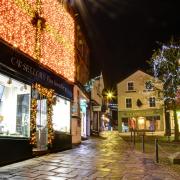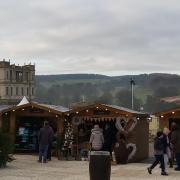Peter Seddon explores the long-lost tradition of village ‘Lock-Ups’.

Although many monuments are lofty memorials to great characters or events, others considered ‘historically important’ are more down to earth. Post boxes, telephone kiosks, milestones, even street lighting, have all found their way onto the National Heritage List.
Among these everyday ‘monuments’ are the once ubiquitous but now dwindled number of ‘village lock-ups’ – small structures of stone or brick, often round with a conical roof, usually a single studded door, perhaps a narrow window or occasionally a fireplace, but really no more than a secure cell for a short uncomfortable stay. Of Britain’s 200 or so surviving examples, Derbyshire has two in accepted classic form, but more loosely almost a dozen.
In essence village lock-ups are now ‘historic buildings that were once used for the temporary detention of people in rural parts.’ They acquired a range of evocative regional nicknames – round house, cage, jug, lobby, watch-house, bridewell, bone-house, blind-house, clink, kitty and cooler. Because they often confined drunks overnight, they have become romantically synonymous with that usage.
Consider this colourful account from 1830: ‘Into the hole were thrust drunken and bleeding men, who were allowed to remain until the following day when the constable with his staff of office takes the poor, crippled and dirty wretches before a magistrate, followed by half the boys and idle fellows of the town.’

But their initial purpose was far broader – most that survive date from the 18th and 19th centuries, when rural communities struggled to police a whole range of misdemeanours – thefts, burglaries, shootings, the obstruction of watchmen and the stealing of livestock. As such, the lock-up became a temporary place of detention – often for a single night – for all manner of rogues and miscreants until they could be removed to a town for trial or longer imprisonment.
The best surviving Derbyshire examples owe their origins to precise legislation. Although prisons and cells have existed since time immemorial, the General Quarter Sessions held at Derby on 12th January 1790 passed the following Court Order: ‘All parishes in the county where there is not already a Round House, House of Correction, or Gaol, shall provide a place of temporary confinement for the reception of vagrants, paupers, felons and the like.’
Thus the archetypal village lock-up originated. The wording is quite telling, for a primary purpose of the Court Order was to provide shelter for the homeless poor. It provided somewhere dry and secure – terribly confined but considered distinctly preferable to a barn or the open air. As such the lock-up was an early if very rudimentary form of social housing – some were occupied ‘permanently’ by a village pauper when not otherwise in use.
The Court Order prompted many parishes to erect such lock-ups. Quick to respond was the South Derbyshire village of Smisby – its lock-up erected in 1790 is now considered the most typical survival in the county. Known as The Jug, with its conical roof, ball finial, weathered door and polygonal shape, its picturesque charm belies a far grimmer past.

The second authentic survival is at nearby Ticknall. Not erected until 1809, it is suggested the delay was because Ticknall already possessed village stocks which served at least part of the same purpose – or perhaps they were simply tardy. Its octagonal form has a quaint romantic air like something from a Gothic fairy tale – again quite at odds with its darker history.
Ticknall lock-up is considered particularly unusual for having a fireplace and associated roof vent – the structure doubled as a sort of sentry-box for the beleaguered village watchman, this being the probable reason for the added comfort.
An amusing anecdote has passed into Ticknall folklore concerning its ‘Round House’. In the mid-19th century Eliza Soar – landlady of the Loaf and Cheese, now the Staff of Life – discovered by chance that the key to her back kitchen also opened the lock-up.
After one raucous Ticknall Wakes in the heat of summer a bunch of ‘merry men’ were ‘thrust in the hole’ by the parish constable who intended to convey them to Derby the next day. After their wives noisily vented their ire Eliza under cover of darkness set the revellers free.

Next morning when the constable found the lock-up secure but empty it was said ‘the look on his bewildered face was a true sight to behold’. The redoubtable Eliza had 15 children – known in later years as ‘Grannie Soar’ she became a Ticknall legend. When she died aged 94 in 1911 an entire age seemed to pass with her.
By then village lock-ups no longer served their original purpose. In the lead-up to the First World War Ticknall’s was being used to store road-mending tools, and during the Second World War the Home Guard kept their weapons in it. Shades of Dad’s Army – perhaps the shovels and rakes were pressed into use.
Just as lock-ups owed their origins to legislation, so their obsolescence was equally sealed. The 1834 Poor Law Amendment Act improved the treatment of paupers. And following the 1839 County Police Act an organised Police Force was introduced. When Ticknall got its own Police House with built-in cells the old ‘Round House’ became a redundant edifice. By 1850 it and countless others had fallen into disuse.
Similar models at Lullington, Church Gresley, Woodville, Swarkestone and other Derbyshire villages failed to survive the ravages of time. That explains why those at Smisby, Ticknall and elsewhere are now Grade II listed as cherished monuments of a lost age.
Although sometimes labelled Derbyshire’s ‘only two surviving lock-ups’ there are other related structures which carry similar designations. A gem among these is the ‘House of Confinement’ on King Street in Alfreton. Dating to 1820, it is a rectangular lock-up with single doorway, two circular windows and a pair of cells. Again Grade II listed, its symmetrical façade almost suggests a friendly face – but if it could speak it would not be of pleasant things.
Another notable intact example is at 44 Church Street in Sandiacre. A plaque dates it 1660 but the present structure is a late 18th century rebuild. Its distinguishing feature is the animal pound or ‘pinfold’ attached to the cells ‘to facilitate ease of management of both human and animal captives’ – rough translation ‘save the legs of the parish constable’. It is both Grade II listed and a scheduled Ancient Monument.
Further examples survive converted to other use – a number in the grounds of private property. Behind 21 Swift’s Hollow in Cromford the old lock-up became a less-romantic garage and store. Rather more idyllic is the Round House or ‘Honey Pot’ nestled in the corner of a field near Curbar. Although on private land it can be seen from a popular public footpath – much-photographed by passing ramblers it has been described as ‘one of the quaintest buildings anywhere in the Peak’.
Dating from the late 18th century, only one up one down, with a conical roof and later chimney pot, it is now a ‘summer house’. Its status as a genuine former lock-up is not entirely certain, but its later history is better-known – until 1937 it was actually lived in by a succession of local characters.
For sheer comfort though the ultimate prize must go to ‘The Old Lock Up’ in Wirksworth. Built in 1842 it now offers an atmospheric Bed & Breakfast experience with en suite rooms called The Magistrate’s, The Solicitor’s, The Coachman’s and The Hayloft – an option not extended to the unfortunate guests of yesteryear. Towards the end of the First World War – when living at ‘Mountain Cottage’ in nearby Middleton – D H Lawrence and his German wife Frieda were required to report to Wirksworth lock-up every week.
In our much-changed world a full century on it is tempting to quote the opening line of L P Hartley’s 1953 novel The Go-Between: ‘The past is a foreign country. They do things differently there.’ But perhaps a note of disquiet yet lingers. Village lock-ups are indeed relics of the past – the Smisby solution of 228 years ago an archaic curiosity. Yet in our supposedly ‘more civilised’ age the same debates still rage – how to accommodate the homeless, incarcerate the lawless, contain irresponsible drinking... and much more besides.
Charles Kingsley’s 1863 work The Water Babies has this stark line: ‘Put him in the round house ‘til he gets sober’. Would it were that simple – in truth the challenges remain and debate divides. What might ‘Granny Soar’ have made of it? Would she use her freedom key today?
What remains more unequivocal is that the old ‘village lock-ups’ are worth preserving as objects of architectural and historic interest. There is even a society, the Village Lock-Up Association, dedicated to their study. Who wouldn’t drink to that? In moderation naturally – great pleasure comes from the clink of a glass… but not from a night in the clink.



























